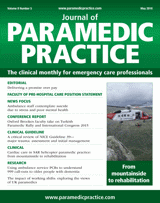Book Review
I often spend my time reflecting on what publishers consider pocket-sized. Now this may seem a touch on the trivial side given the contemporary issues currently facing our profession. But consider, if you will, the potential cost savings in uniform issue from burst trouser seams due to bulging pockets (not waist bands).
So to the content. I think it prudent to leave any review of individual drug regimes to the clinical nous of each ambulance service, for which these guidelines were written, and focus more on the structure and philosophy behind them.
It is good to see the ‘page for age’ section has been retained from the 2013 edition. It is a quick and reliable tool for clinicians and is fast becoming the hallmark of these guidelines. Praise is also due for the continued inclusion of valuable decision-making aids such as the National Institute for Health and Care Excellence guidelines for febrile illness, triage models, and a revised mental capacity assessment tool is a welcome addition.
Subscribe to get full access to the Journal of Paramedic Practice
Thank you for visiting the Journal of Paramedic Practice and reading our archive of expert clinical content. If you would like to read more from the only journal dedicated to those working in emergency care, you can start your subscription today for just £48.
What's included
-
CPD Focus
-
Develop your career
-
Stay informed

